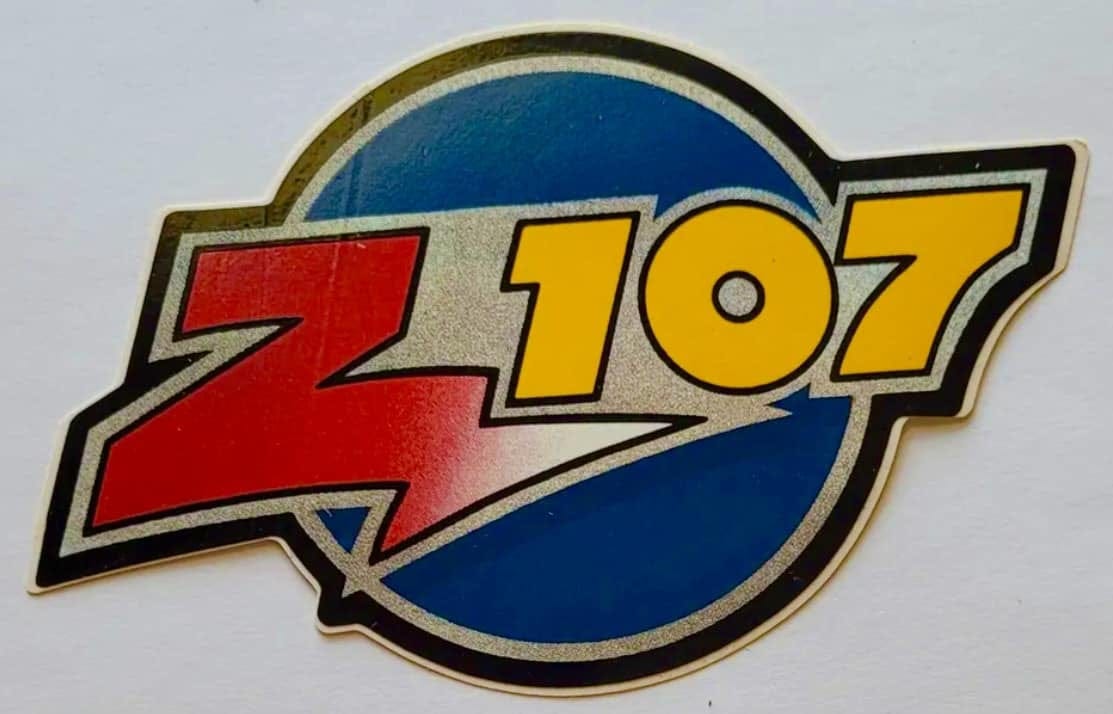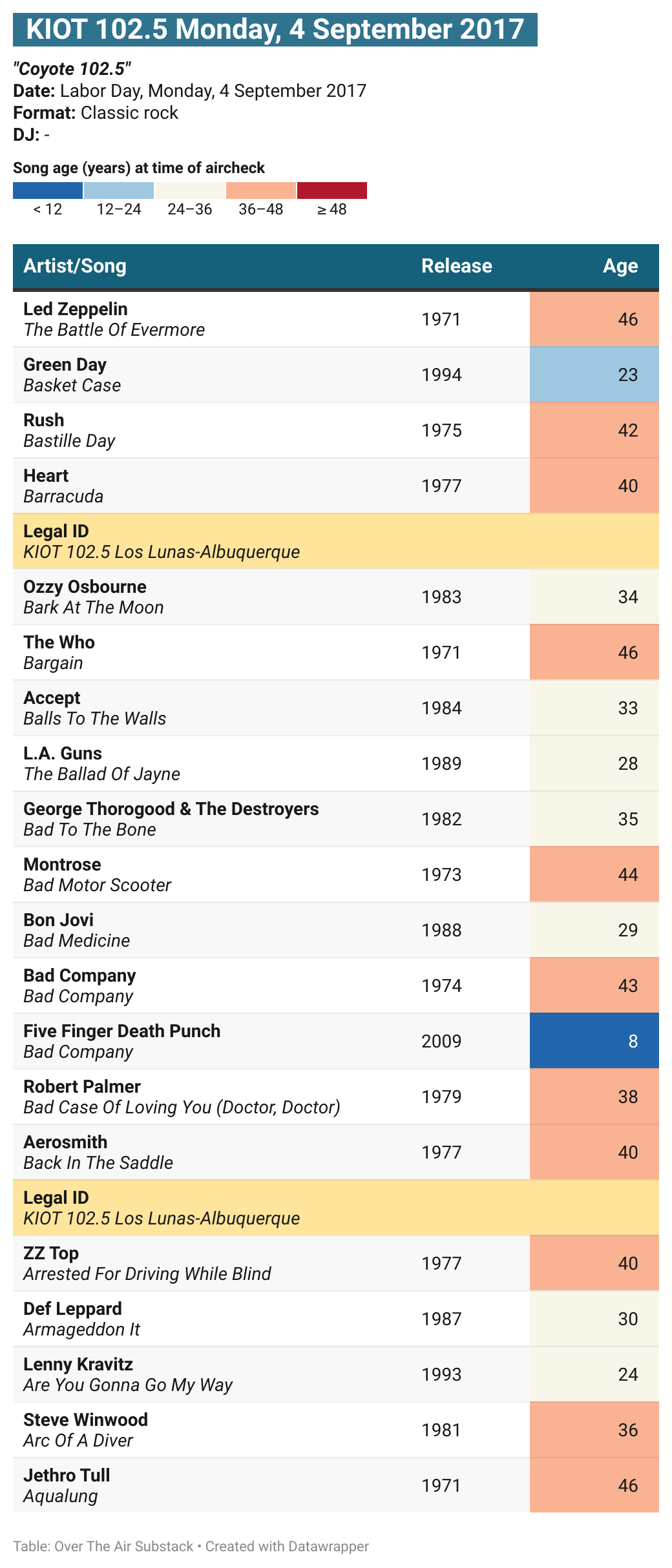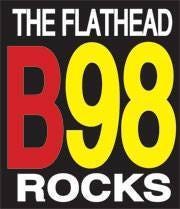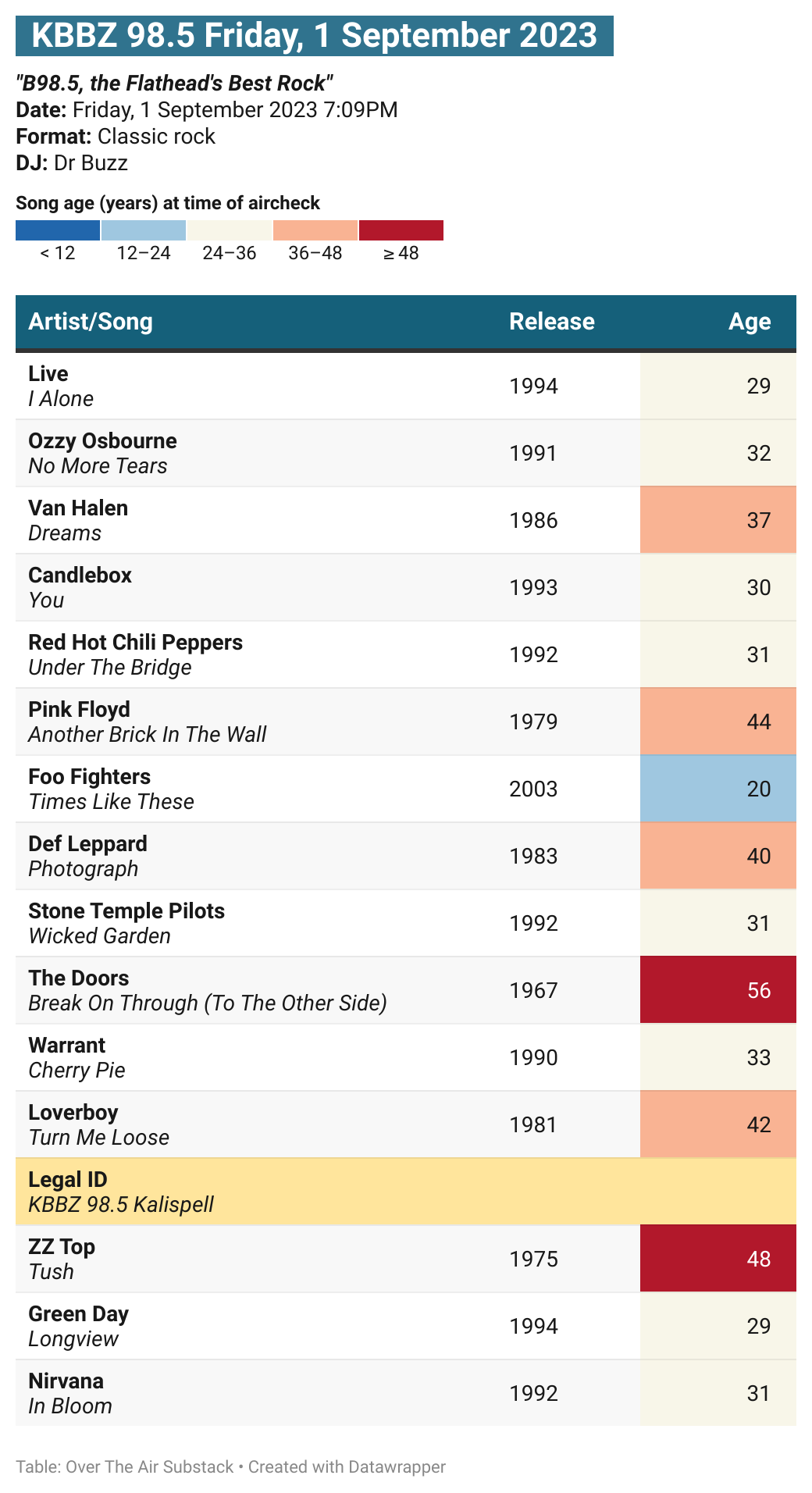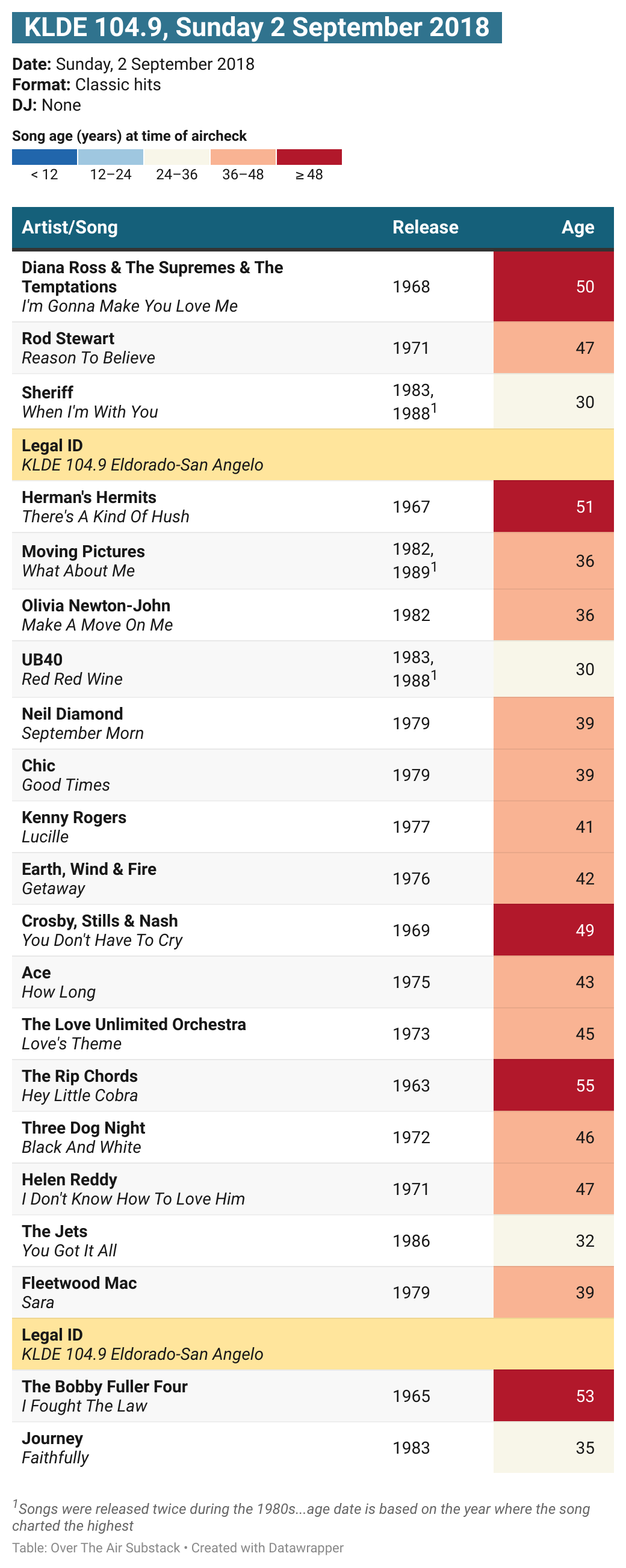Radio This Week Back Then #33: September 1-7
The XXL Classic Rock and Classic Hits edition...audio from 13 stations this week
What was on the radio this week…back then. This is a weekly visit of radio audio from this week in past years for those that enjoy radio history, those working in radio looking for promotional ideas, or stations looking to re-find lost audio of their heritage. If you enjoy these weekly audio rewinds, they take a lot of time to put together, so please do me a favor, subscribe, and share and pass it on. Thank you! A searchable and sortable index of all the audio is located on the Aircheck Index page.
Each week, I run a query on my list of airchecks to see which ones I have that fall in the upcoming week that are potential candidates for this weekly rewind. Sometimes in the list there are patterns or themes that stick out like last week’s edition featuring format changes. For this week, one pattern I did see was a lot of of “classic” formats — classic hits and classic rock. As well, they spanned across several decades. So, I thought it might be interesting to pull those and look at how both formats have evolved — or not really evolved.
So, this week is an extra large serving of audio of 13 airchecks from 13 stations I have not yet previously posted any audio from. Normally, I order the audio from largest market or metro area to smallest. This week, I have grouped them into the two formats — classic rock and classic hits. Within each group, I ordered them by date of the recording.
In this edition are the following classic rock outlets, from earliest to the most recent audio recordings:
Houston | KZFX 107.5 “Z107”
Syracuse | WKFM 104.7 “Kix 104.7”
Corpus Christi | KWVS 97.5 “97.5 the Waves”
Little Rock | KMJX 105.1 “Magic 105”
Albuquerque | KIOT 102.5 “Coyote 102.5”
Kalispell MT | KBBZ 98.5 “B98.5” and KZMN 103.9 “106.7 & 103.9 the Monster”
And the following classic hits outlets:
Austin | KHHT 93.3 “Hits 93.3”
Albuquerque | KABG 98.5 “Big 98.5”
Shreveport | KLKL 95.7 “the River 95-7”
San Angelo TX | KCLL 100.1 “100.1 Cool FM” and KLDE 104.9
Kalispell MT | KWOL-FM 105.1 “Kool 105”
Classic Rock
I have mentioned this in previous editions: I find it intriguing how slow most classic hits and classic rock stations have been to evolve their music libraries to “less old” music.
When the classic rock format took off in the mid to late 1980s, it was primarily centered on the 1970s, with some 1960s and some 1980s music in the mix. My first classic rock station experience was when I was in college, and Houston’s KZFX 107.5 “Z107” came on the air. The first aircheck this week is from them in 1990, 4 years into their run in the format. On that audio, none of the songs are older than 25 years old and a few were under a decade old at the time. On many classic rock stations today, that has become inverted — it’s atypical to hear a song under 25 years of age.
A little fun with charts before the audio. For the 7 classic rockers this week, the airchecks span 40+ years and fall into four different decades — three were recorded in the early 1990s, one in the 2000s, one in the 2010s, and two from this decade recorded last year.
From the song log of each station, I pulled out the year each song was released and how old that song was at the time of the aircheck recording. I color coded the stations based on the decade of the recording and plotted it out…
A couple of things stick out…
Even though the airchecks span more than 40 years, all the stations are heavily 1970s and 1980s — then and now.
Because the core music libraries are not changing much, the plot pattern keeps repeating, but shifting to the right since the songs are the same but getting older and older.
In fact, by just charting on song age for each station, you can see how the format has shifted from KZFX in 1990 to where the songs were under 25 years to KZMN last year where no song was under 30 years old.
For each of the classic rock stations, in the song log for each aircheck below, I added a song age column. The coloring of the column is using the same scale for each station. As you scroll from earliest to most recent audio recording, you can see that column progressively shifting from blues (<12, 12-24 year old songs) to reds (36-48, > 48 year old songs).
Related: Houston
As discussed by the on-air staff in this audio, KZFX signed on the air 8 September 1986, with the first song being The Rolling Stones’ “You Can’t Always Get What You Want.” Z107 was getting ready for its 4th birthday party event to mark the occasion. KZFX was not the first classic rock station in the market; like Dallas/Fort Worth, Houston’s first classic rock station was an AM outlet, KRBE 1070. KRQX 570 Dallas went to AOR gold in 1983, beating KRBE to the format, but KRBE coined the “Classic Rock” name first. A new FM competitor in Z107 sent KRBE to simulcasting sister top 40 KRBE-FM 104.1.
In 1994, Z107 became short-lived modern rock KRQT “Rocket 107.” KRQT was rebranded as KTBZ “New Rock 107-5 the Buzz” the following year. On 18 July 2002, with Clear Channel needing to divest a signal and opting to get rid of the 107.5 facility, KTBZ’s calls and format exchanged dial positions with classic hits KLDE 94.5, which has a better full market signal. KTBZ still is on the air today at 94.5. As for 107.5, KLDE later rebranded as “K-Hits” KHTC and then later returned to classic rock as KGLK “the Eagle,” which it remains today with simulcast KHPT 106.9 to cover the northern part of the metro. The KLDE calls now belong to one of the classic hits stations later in this newsletter.
The WKFM calls dated back to the 1970s. WKFM shifted from top 40 to AOR in the mid-1980s, and that led to the shift to classic rock several years after that.
Like the KZFX aircheck above recorded just a year earlier, Kix also largely was playing rock tracks that were released within the last 25 years.
WKFM flipped to country WBBS “B104.7” in 1993, and it remains so still today.
Related: Corpus Christi
Originally a class A outlet on 97.7 as KDUV, the station upgraded to 100 kw as a C1 on 97.5 in January 1989, giving it full coverage of the Corpus Christi market. On the new facility, it’s initial format was new age/smooth jazz KWVS “the Waves 97.5.” It shifted to AAA in 1990 and ran with that for several years. By 1994, when I recorded this on a trip, it was classic rock and had brought back the “Waves” handle. It became country KFTX “Wild Country” the following year in 1995. Today, it is still country KFTX, but using “Real Country” as its handle.
Related: Little Rock
Dating back to 1990, the KMJX calls and “Magic 105” brand had a long run in Little Rock. The brand ended in 2008 when KMJX became classic country “105.1 the Wolf,” which remains its current day format.
As this aircheck is from 2002 and about a decade after the previous three above, the average age of songs played has jumped.
Fast forward a decade and a half, and we have hit 2017. With that, the colors on the age column have moved into the reds. 9 of the songs are 40 years old or older.
This is a pretty good sounding aircheck…for the Labor Day weekend, it ran a “Z-to-A” run through the library instead of the typical “A-to-Z weekend” promotion. So, the song titles are going in reverse order, and this aircheck takes you through “The Battle Of Evermore” (the “The” doesn’t count…) through “Aqualung.”
A year ago, I was in Kalispell to experience Glacier National Park and the Montana mountains and escape the 100+ degree heat of Texas.
There is a lot of classic hits, classic rock, classic country, and oldies stations on the dial in this market. Given the older median age and the city’s racial make up being 94% white, that may explain the proliferation of those formats.
This is the first of the two classic rockers in the market. Both classic rock outlets are part of clusters of locally owned stations. With that, there is also, remarkably, local DJs in some shifts.
When I was there last year, KBBZ was running contests around its 40th anniversary as a rock outlet. Musically, it is different than rival KZMN below. KBBZ included a decent number of tracks from the 1990s in its library, though since we are now in the 2020s, it still meant most songs were well over 25 years old — a 20 year old Foo Fighters song being the exception. It also had the widest span of years as, aside from that 2003 song, they played a track from The Doors from 1967 that was 56 years old at the time of the aircheck.
This was the local evening shift, which, according to their current schedule, is now filled by syndicated programming. Dr Buzz, the jock on this aircheck, is now middays.
Unlike rival KBBZ above, KZMN’s song set below could have been played on KZFX or WKFM at the top of this post as there wasn’t anything later than the 1980s when I recorded them.
The 106.7 reference in the branding refers to their K294CK 106.7 Whitefish translator. This is from their morning drive shift. Some of the DJs within the cluster had shifts on more than one station within the cluster. I suspect that is a compromise, as a local group of stations, that keeps the main shifts with a local DJ as opposed to automation or syndicated fare.
Classic Hits
When the modern day classic hits format emerged in most markets in the mid-1980s, the bulk of them were playing hits from late 1950s through the early to mid-1970s. They were centered in the 1960s….songs were about 20 years old on average. As the 1980s gave way to the 1990s, most classic hits stations jettisoned the 1950s tracks. By that logic, a classic hits station today would be basically centered on the 2000s with a few tracks from the late 1990s and some from the early to mid-2010s. The 1980s would have long been gone. Certainly, in 1985, no major market classic hits station was playing the hits from four decades before, the 1940s…that was relegated to adult standards outlets.
Unlike the classic rock group above, I didn’t have an aircheck this week from the 2000s decade, but the other decades are covered to see a similar trend for the classic hits format where the average age of songs is getting older and older.
Certainly, today, there are some classic hits stations that have begun embracing more 1990s material, but that is still material that is over a quarter of a century old and those ‘90s songs are still often mixed in with a lot of 1980s material that is now 34-44 years old. It will be interesting to see if the recent “throwback” format attempts (re-current heavy CHRs or rhythmic throwbacks) hold and influence some classic hits stations to lurch forward in time.
Related: Austin
Up first is the beleaguered 93.3 facility in Austin. Originally licensed to Killeen and serving the Killeen/Temple area, the former top 40 KIXS constructed a nearly 2000’ tower between Killeen and Austin and fired it up in late 1986 and began targeting Austin as top 40 KBTS “B93.” It has been a parade of format changes and rebrands ever since, the 18th one since B93 came on occurred just last week.
With 13 airchecks, I did not have time this week to create the detailed station profiles I normally try to add. But, here is the summary of the 18 format changes and rebrands since 1986:
In 1991, KBTS shifted to rhythmic/dance top 40 “B93 Jamz.”
29 May 1992: KBTS flipped to hot AC “Mix 93.3.” The calls changed to KMXX in September.
23 February 1993: After stunting with sound effects all weekend, hot AC KMXX became country “Lone Star 93.”
April 1993: Country KMXX relaunched as “hot country” KHHT “Hot 93.”
1 Sep 1994: Country KHHT flipped to classic hits “Hits 93.3, the ‘70s Station, the Greatest Hits of the ‘70s.”
16 November 1995: Classic hits KHHT flipped to smooth jazz. Calls changed to KAJZ in January.
18 September 1998: Smooth jazz KAJZ changed to country "Lone Star 93.” Calls changed to KLNC in October.
August 2001: Country KLNC changed to rhythmic top 40 KXMG "Mega 93-3/99-7.”
15 August 2003: Rhythmic CHR KXMG shifted to R&B “Hot 93.3.” The calls flipped to KDHT on the 18th.
20 November 2009: Co-owned AAA KGSR 107.1’s format and calls began simulcasting on KDHT 93.3, replacing the hip hop format. On 30 November, the 107.1 facility flipped to regional Mexican, with the AAA format migrated to 93.3 as its new home. The 93.3 calls changed to KGSR in December.
6 September 2018: AAA KGSR relaunched as “Austin City Limits Radio.” With the relaunch, KGSR added a simulcast on translator K246BD 97.1 Austin.
8 March 2019: AAA KGSR flipped to soft AC “Star 93.3.” The AAA “Austin City Limits Radio” remained on K246BD and KGSR’s HD2 channel.
14 February 2020: Soft AC KGSR shifted to hot AC, retaining the “Star 93.3” brand.
18 September 2020: Hot AC KGSR “Star 93.3” flipped to top 40 “93.3 Austin, New Music Now.”
18 November 2020: After two months, CHR KGSR flipped back to hot AC “93.3 Austin.”
4 January 2021: Hot AC KGSR rebranded as “Lucy 93.3.”
12 July 2023: Hot AC KGSR flipped to Spanish CHR “Latino 93.3.”
30 August 2024: KGSR’s Spanish CHR format moved to translator K246BD 97.1, displacing AAA “Austin City Limits Radio,” which remained on KGSR-HD2. KGSR flipped to rhythmic throwbacks “Vibe 93.3.”
This aircheck is from the KHHT “Hits 93.3” era of 1994. At this time, there was some stations experimenting as all or mostly 1970s outlets as traditional classic hits outlets at the time were running hits of the 1960s and 1970s. CBS’s “Arrow”-branded — the name derived from the first letters of the slogan “All Rock and Roll Oldies” — stations hitting markets like LA (KCBS-FM 93.1), Dallas (KRRW 97.9), Houston (KKRW 93.7), and DC (WARW 94.7) helped inspire others. KHHT was one of those all-’70s outlets.
Recorded the same time as the KIOT classic rock aircheck further above, this is a midday aircheck of classic hits rival KABG. The first half of the aircheck is part of an all-request lunch, which seems novel these days as middays is no longer staffed or local on so many stations.
KABG has been in the format quite a while — originally as “Big Oldies 98.5” in 1997. It dropped the “Oldies” part from its name when the use of “oldies” became no longer en vogue in the industry. It remains classic hits “Big 98.5” today.
Much like the classic rock outlets, at this point, the song ages have really crept up.
Recorded the same week in 2017, but several hundred miles to the east, comes this aircheck from Shreveport’s classic hits station. KLKL’s library differs from KABG in that KLKL included some songs from the late 1980s and even some 1990s. So, the average age of songs played here is younger than KABG at the time.
Aside from that, the aircheck is rather unremarkable. Unlike KABG above, with a pretty interactive caller-driven show, KLKL is just automated with no jock presence or any personality at the time of this recording. If you listen to this, it is easy to figure out why some people have abandoned local radio listening in favor of podcasts or streaming services.
Related: San Angelo
Now, for something completely different… San Angelo is a really, really small market. At this time in 2018, it had two competing classic hits stations. Both are locally owned as well.
This first one, KCLL, is not local — it’s running Westwood One’s Classic Hits network. I included it just to keep the wide cross-section of stations (owners, markets, years) in this review of the classic hits format.
Certainly not a generic national network feed described rival KLDE. It ran a all-over mix of classic hits. No one could ever say they were cookie cutter. It is certainly not slickly produced nor sounds like it is guided by a consulting company.
Unfortunately, the brutal Texas winter storm of February 2001 that ended up killing over 240 people in the state silenced KLDE when its tower can crashing down outside its studios in the small town of Eldorado, south of San Angelo. From FCC records, it looks like it has basically been off the air since then, but still licensed under various STAs.
KLDE’s 104.9 signal did not cover San Angelo; instead, it used the K287AT 105.3 translator to reach the metro.
From the song log, they ended up playing 3 songs that charted twice — Sheriff’s “When I’m With You,” Moving Pictures’ “What About Me,” and UB40’s “Red Red Wine.” I included both the original and re-released year, but for the song age, I went with the year the song charted the highest on the Billboard Hot 100. An obscure fact while researching all that, between its first chart run and its second chart run, “What About Me” was on the Hot 100 for a combined 43 weeks, which, at the time, was the second longest run of any single. Given it has really minimal airplay on most classic hits stations over the years, it’s a surprising length of time on that chart.
While in Kalispell last year, aside from the two classic rockers, I also recorded this AM drive audio of classic hits KWOL-FM 105.1. At the time, Kool 105 had shifted to primarily be focused on the ‘80s. With the move, there are still no songs under the age of 30, but, unlike a couple of stations above, there also is not any songs over 50 years of age.
As always, the logos and other intellectual property belong to the stations. The recordings were made from over the air broadcasts.





